Darkling beetle
Darkling beetle is the common name of the large family of beetles Tenebrionidae. The number of species in the Tenebrionidae is estimated at more than 20,000 and the family is cosmopolitan in distribution.
| Darkling beetle | |
|---|---|
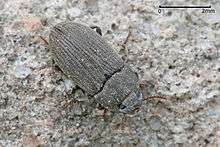 | |
| Alphitobius sp. (Tenebrioninae: Alphitobiini) Scale bar (top right) is 2 mm | |
| Scientific classification | |
| Kingdom: | Animalia |
| Phylum: | Arthropoda |
| Class: | Insecta |
| Order: | Coleoptera |
| Suborder: | Polyphaga |
| Infraorder: | Cucujiformia |
| Superfamily: | Tenebrionoidea |
| Family: | Tenebrionidae Latreille, 1802 |
| Subfamilies | |
|
See text | |
Taxonomy
Tenebrio is the Latin generic name that Carl Linnaeus assigned to some flour beetles in his 10th edition of Systema Naturae 1758-59.[1]. The word means "seeker of dark places"[2] (or figuratively a trickster); an English language analog is "darkling".[3]
Numerous Tenebrionidae species do inhabit dark places, however, there are many species in genera such as Stenocara and Onymacris, which are active by day and inactive at night.
The family covers a varied range of forms, such that classification presents great difficulties. The following list of subfamilies was largely accepted in 2005.[4]
- Alleculinae Laporte, 1840
- Cossyphodinae Wasmann, 1899
- Diaperinae Latreille, 1802
- Lagriinae Latreille, 1825 (1820)
- Nilioninae Lacordaire, 1859
- Phrenapatinae Solier, 1834
- Pimeliinae Latreille, 1802
- Stenochiinae Kirby, 1837
- Tenebrioninae Latreille, 1802
- Zolodininae Watt, 1974
Ongoing phylogenetic studies are showing that some taxonomic changes are needed. For instance the tribal classification of tribe Pedinini has recently been altered.[5]
The misspelling "Terebrionidae" occurs frequently enough to be easily overlooked.[6][7] The error appears to have no particular significance, but to be the product of misreadings, mis-scans and mis-typings.
.jpg)
Characteristics
The Tenebrionidae may be identified by a combination of features, including:
- Their 11-segmented antennae that may be filiform, moniliform or weakly clubbed
- First abdominal sternite is entire and not divided by the hind coxae
- Eyes notched by a frontal ridge
- The tarsi have four segments in the hind pair and five in the fore and mid legs (5-5-4), tarsal claws are simple
Biology and ecology
Tenebrionid beetles occupy ecological niches in mainly deserts and forests as plant scavengers. Most species are generalistic omnivores, and feed on decaying leaves, rotting wood, fresh plant matter, dead insects, and fungi as larvae and adults.[8] Several genera, including Bolitotherus, are specialized fungivores which feed on polypores. Many of the larger species are flightless, and those that are capable, such as T. molitor, only do so when necessary, such as when dispersing or malnourished.[9][10][11]
_tribulus_larva.jpg)
The larvae, known as mealworms or false wireworms, are usually fossorial, heavily armored and nocturnal. They may possibly be an important resource for certain invertebrates and small mammals. However, the adults of many species have chemical defenses and are relatively protected against predators.[10] Adults of most species, except grain pests, have slow metabolisms, and live long lives compared to other insects, ranging from approximately six months to two years.
Some species live in intensely dry deserts such as the Namib, and have evolved adaptions by which they collect droplets of fog that deposit on their elytra. As the droplets accumulate the water drains down the beetles' backs to their mouthparts, where they swallow it.[12]
Humans spread some species such that they have become cosmopolitan, such as Tribolium castaneum, the red flour beetle, which was spread through grain products.
Notable species
The larval stages of several species are cultured as feeder insects for captive insectivores or as laboratory subjects:
- Tenebrio molitor is commonly used to feed terrestrial amniotes kept in terraria.
- Tribolium castaneum is a laboratory animal useful as a model organism, especially in studies of intragenomic conflict and population ecology.
- Zophobas morio, or superworm, is valued as a feed for captive reptiles; it contains less chitin than Tenebrio molitor.
- Alphitobius diaperinus, lesser mealworm[13]
- Many tenebrionids are pests of cereal and flour silos and other storage facilities, including T. castaneum, other Tribolium species such as Tribolium confusum and Tribolium destructor, and Gnathocerus cornutus.
- In southwestern North America, species of the genus Eleodes (particularly E. obscurus) are well known as "pinacate beetles" or "desert stink beetles".
- Several genera, such as Stenocara and Onymacris, are of interest in ecological studies of arid conditions and their associated adaptations.
- Ulomoides dermestoides, known as "chinese weevil", "peanut beetle", "cancer beetle", or "asthma beetle", is eaten in Argentina where it is thought to be a treatment for cancer, asthma, and other illnesses.
Gallery
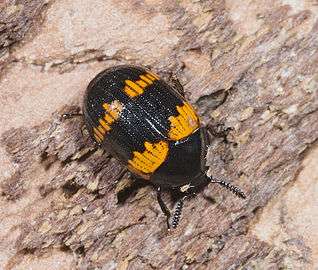 Diaperis boleti under bark of oak.
Diaperis boleti under bark of oak.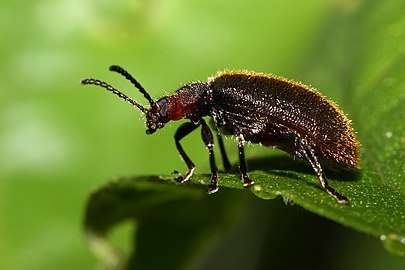
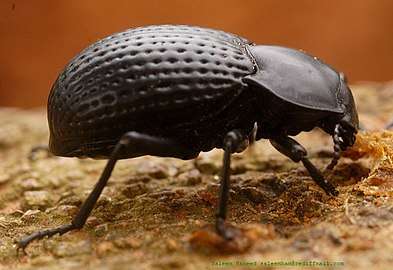 Platynotus excavatus, India
Platynotus excavatus, India Stenocara dentata in southern Africa
Stenocara dentata in southern Africa_(3989862005).jpg) Gonopus tibialis
Gonopus tibialis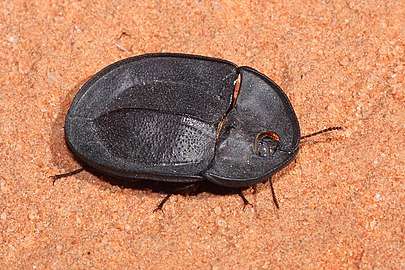 Pie dish beetle, Helea sp. in Australia
Pie dish beetle, Helea sp. in Australia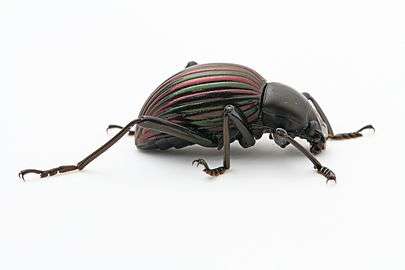 Hegemona sp. (De Laporte, 1840) from Belize
Hegemona sp. (De Laporte, 1840) from Belize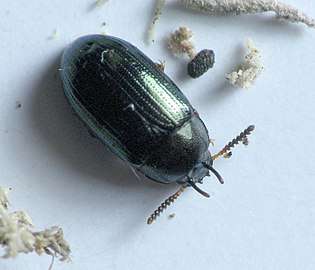 Neomida bicornis, male
Neomida bicornis, male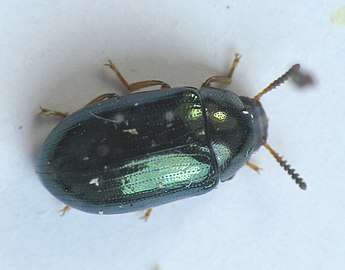 Neomida bicornis, female
Neomida bicornis, female
References
- "Caroli Linnæi ... Animalium specierum in classes, ordines, genera, species, methodica dispositio ." Internet Archive.
- Jaeger, Edmund Carroll (1959). A source-book of biological names and terms. Springfield, Ill: Thomas. ISBN 0-398-06179-3.
- Brown, Lesley (1993). The New shorter Oxford English dictionary on historical principles. Oxford [Eng.]: Clarendon. ISBN 0-19-861271-0.
- Bouchard, Patrice. Lawrence, John F. Davies, Anthony E. Newton, Alfred F. Synoptic Classification of the World Tenebrionidae (Insecta: Coleoptera) with a Review of Family-Group Names. ANNALES ZOOLOGICI (Warszawa), 2005, 55(4): 499-530
- Kamiński, M.J.; Kanda, K.; Lumen, R.; Smith, A.D.; Iwan, D. (2019). "Molecular phylogeny of Pedinini (Coleoptera, Tenebrionidae) and its implications for higher-level classification". Zoological Journal of the Linnean Society. 185 (1): 77–97. doi:10.1093/zoolinnean/zly033.
- Dennis S. Hill (1997). The Economic Importance of Insects. Springer Science & Business Media. pp. 109–. ISBN 978-0-412-49800-8.
- "Egyptian Beetle (Blaps polychresta)".
- "Species Bolitotherus cornutus - Forked Fungus Beetle".
- Flying Mealworm Beetle (Tenebrio molitor) on YouTube
- "Family Tenebrionidae - Darkling Beetles".
- "Bolitotherus cornutus". Archived from the original on 2016-03-04. Retrieved 2015-08-14.
- "Desert beetles inspire aircraft design that doesn't freeze". ZME Science. 2016-01-25. Retrieved 2016-01-27.
- Alphitobius diaperinus, lesser mealworm. University of Florida IFAS